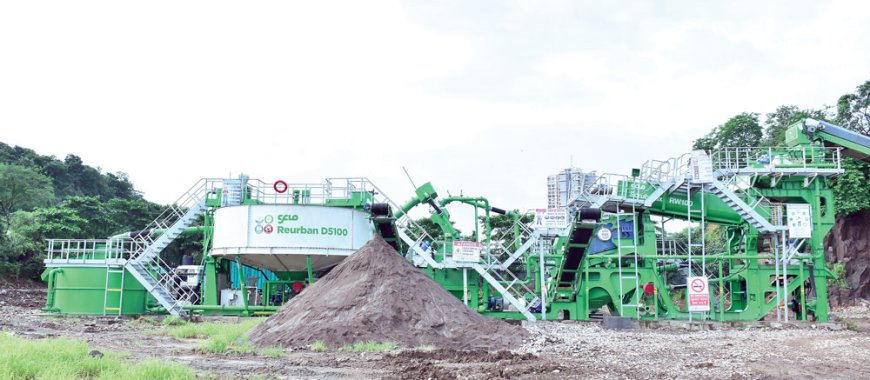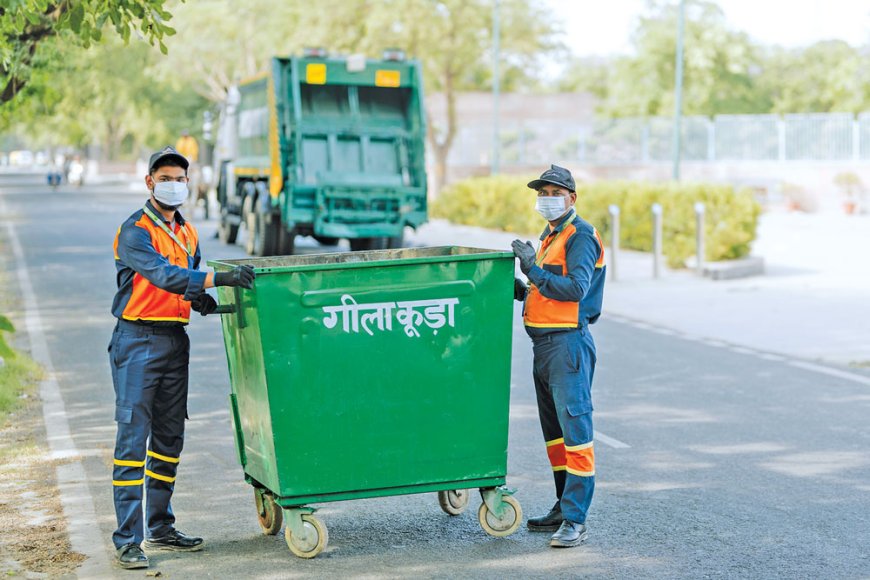Jose Jacob Kallarakal
Chairman & MD, Antony Waste Handling Cell Ltd
Growing urbanisation and infrastructure developments generate solid municipal waste in large quantity. How do you look at this as a threat to the environment and sustainability?
The rapid urbanization and infrastructure development in India pose significant challenges to environmental sustainability, primarily through the generation of municipal solid waste (MSW). As urban areas expand, the volume of waste produced increases dramatically, creating a pressing need for effective waste management strategies. Urbanization has led to a substantial rise in waste generation, with estimates indicating that urban India produces between 1,30,000 to 1,50,000 metric tonnes of MSW daily, projected to reach 165 million tonnes by 2030. This surge not only overwhelms existing waste management systems but also exacerbates pollution and environmental degradation.
Landfills, which are the most common method of waste disposal, occupy vast tracts of land that could otherwise be used for agriculture, wildlife habitats, or urban green spaces. As landfills reach capacity, they release harmful greenhouse gases such as methane, which significantly contribute to climate change. The decomposition of organic waste in landfills also produces leachate, a toxic liquid that can seep into the soil and contaminate groundwater sources.
The mismanagement of solid municipal waste poses serious public health risks. The accumulation of waste in urban areas can also lead to the spread of infectious diseases, particularly in densely populated regions with inadequate waste management infrastructure. Communities living near landfills and waste disposal sites are often exposed to hazardous pollutants, leading to respiratory problems, skin diseases, and other health issues.
With inadequate processing capacity—historically at only 18% in 2014 and improving to around 70% by 2021—many cities still struggle with the safe disposal of waste. The production and disposal of waste require substantial amounts of energy and natural resources, thereby depleting valuable resources and increasing the carbon footprint. The rapid pace of urbanization often outstrips the development of necessary waste management infrastructure. Local authorities frequently lack the resources and knowledge required to implement effective waste collection, segregation, and processing systems, resulting in inefficient service delivery and increased public health risks.
Despite the introduction of various regulations aimed at improving waste management—such as the Swachh Bharat Mission—implementation remains inconsistent across different regions. Many urban local bodies (ULBs) face challenges in adhering to guidelines for source segregation and door-to-door collection.
Effective waste management requires active participation from citizens, yet public awareness and involvement often fall short. Initiatives that foster community engagement are essential for achieving sustainable practices like recycling and composting.
While these challenges are significant, they also present opportunities for innovation in waste management practices. By adopting a circular economy approach, communities can transform waste from a liability into a resource. This involves implementing robust recycling programs to reduce the volume of waste sent to landfills while recovering valuable materials, collaborating with private sector stakeholders to improve infrastructure and technology adoption for more efficient waste processing, and increasing public awareness about waste segregation and reduction to foster a culture of sustainability within urban communities. In conclusion, while growing urbanization presents serious threats to environmental sustainability through increased solid municipal waste generation, it also opens avenues for innovative solutions that can enhance both ecological health and economic growth in developing economies like India. Addressing these challenges with strategic planning and community involvement is crucial for achieving long-term sustainability goals.
 Recycling is the ideal way to minimise the impact of solid municipal waste. How is the company contributing to recycling of waste materials?
Recycling is the ideal way to minimise the impact of solid municipal waste. How is the company contributing to recycling of waste materials?
Antony Waste is actively contributing to the recycling of waste materials as part of its comprehensive waste management strategy, emphasizing the principles of Reduce, Reuse, and Recycle to minimize the environmental impact of solid municipal waste.
The company operates integrated systems that encompass the entire waste management process, from collection and transportation to treatment and scientific disposal, facilitating effective recycling and resource recovery to ensure valuable materials are diverted from landfills. It has established Material Recovery Facilities (MRFs) that sort waste to recover recyclable materials, including compost and refuse-derived fuel (RDF), which are crucial for sustainable waste management.
Utilizing cutting-edge technologies, Antony Waste employs mechanical and biological treatment methodologies for systematic segregation and sorting of diverse waste streams, enhancing recycling efficiency while reducing landfill volumes. For e.g., at its Kanjur facility, the company managed to convert inorganic fractions into high quality calorific rich RDF (Refuse Derived Fuel) which is used by cement companies, as an alternative to coal as their fuel. The company is also involved in bio-mining projects that reclaim valuable resources from landfills, further promoting recycling efforts and rehabilitating previously used land.
In the financial year 2024-25, Antony Waste achieved a significant milestone by selling over 1,47,000 tonnes of RDF. By converting waste into RDF, which is then used as an alternative to coal by cement companies, the company helps reduce reliance on finite natural resources. This approach not only addresses the challenge of managing non-recyclable waste but also contributes to environmental sustainability by decreasing the dependency on natural coal reserves and reducing the overall carbon footprint.
Additionally, Antony Waste is expanding its initiatives to include specific materials such as waste tires, end-of-life vehicles, and plastics, reflecting its commitment to evolving waste management trends and embracing a circular economy. Through its waste-to-energy facility, the company converts organic waste into clean energy, reducing reliance on fossil fuels while simultaneously promoting recycling by transforming waste into usable resources. Overall, Antony Waste is making significant strides in minimizing the impact of solid municipal waste through extensive recycling efforts, advanced technological integration, and a commitment to sustainable practices.

The company has successfully constructed demonstration road utilizing ‘end-of-life’ plastic rejects from the Kanjurmarg integrated processing facility. This 270-meter road, built in collaboration with IIT Bombay, marks a significant step forward in repurposing waste that would otherwise remain in landfills.
For the construction, 6% melted shredded plastic, sourced directly from plastic rejects from the Kanjurmarg integrated processing facility, was used with bitumen in the road mix. This method reduces dependency on traditional bitumen, while addressing the challenge of disposing of non-recyclable plastic waste.
Construction and demolition (C&D) waste creates a lot of ecological issues in the long run. What are the technologies and solutions offered in C&D waste recycling?
Antony Waste employs advanced wet processing technology in its C&D waste recycling operations to effectively address the ecological challenges posed by C&D waste. This technology is crucial for maximizing material recovery and ensuring the production of high-quality recycled aggregates and sand.
Wet processing involves several stages that enhance the recycling efficiency of mixed C&D waste. Initially, the waste is subjected to a thorough separation process, which includes the removal of contaminants such as clay, metals, plastics, and other unwanted materials. This is achieved through various stages of washing and screening, where water is used to liberate fine particles and separate them from heavier aggregates. The use of water not only aids in cleaning the materials but also minimizes dust emissions and noise pollution, making the process more environmentally friendly.
One significant advantage of wet processing is its ability to recover up to 95% of incoming C&D waste, transforming it into valuable resources that can be reused in construction applications. For instance, recycled aggregates produced through wet processing can replace natural materials in concrete and asphalt production, contributing to sustainable building practices. Additionally, this method allows for the production of multiple grades of recycled materials, catering to various construction needs.
Antony Waste's implementation of wet processing technology aligns with global trends in C&D waste management, where facilities are designed to handle varying levels of contamination and material types. Each recycling plant is tailored to meet specific project requirements, ensuring optimal performance and resource recovery.
Can you give us an overview on how the company is using recycled materials in its projects?
Antony Waste is actively integrating recycled materials into its projects as part of its commitment to sustainable waste management. The company employs advanced technologies to process various types of waste, including C&D debris, municipal solid waste, and plastics. Through its specialized Material Recovery Facilities, Antony Waste efficiently separates and recycles materials, producing high-quality aggregates that can be reused in new construction projects. This not only helps reduce the consumption of natural resources but also minimizes landfill dependency.
The company has made significant strides in utilizing recycled materials in road construction, particularly through initiatives that incorporate plastic waste into asphalt. This approach enhances the durability of roads while addressing the growing issue of plastic pollution. Additionally, Antony Waste's recent collaboration with IIT Bombay to explore the use of End-of-Life plastics in road building exemplifies its innovative efforts to repurpose waste materials effectively.
Antony Waste is also involved in bio-mining projects that reclaim valuable resources from legacy waste sites. By processing large volumes of municipal solid waste, the company recovers materials like refuse-derived fuel (RDF) and compost, which are essential for promoting a circular economy. These initiatives underscore Antony Waste's dedication to environmental sustainability and highlight its role as a leader in the Indian waste management sector.
How is roads segment emerging as a major contributor to utilising solid waste like plastic waste?
The road construction segment in India is increasingly emerging as a significant contributor to the utilization of solid waste, particularly plastic waste, through innovative practices and technologies. The Indian government's initiatives, spearheaded by Union Minister Nitin Gadkari, focus on integrating sustainable materials into road building, thereby addressing environmental concerns associated with plastic waste.
One of the notable advancements is the use of plastic waste in road construction, which has been successfully implemented in various projects across the country. Gadkari has highlighted that approximately 246 lakh metric tons of plastic waste have been utilized in constructing around 854 km of roads. This method typically involves incorporating 6-8% of plastic waste into conventional bitumen, enhancing the durability and longevity of the roads while simultaneously reducing the volume of plastic that would otherwise end up in landfills.
Furthermore, Antony Waste has recently collaborated with IIT Bombay to explore innovative applications of End-of-Life (EOL) plastics in road construction. This partnership aims to develop sustainable road materials that not only utilize discarded plastics but also improve the overall performance of road infrastructure.
In addition to these efforts, the introduction of bio-bitumen—a sustainable alternative to traditional fossil-derived bitumen—further complements the drive towards eco-friendly road construction. This bio-bitumen can be blended with conventional materials, reducing reliance on imported bitumen and promoting local agricultural waste utilization. The successful implementation of these technologies not only addresses the pressing issue of plastic waste but also aligns with broader sustainability goals, aiming for a greener and more self-reliant future for India's infrastructure development.
What are the emerging opportunities in waste recycling? What is your vision on a sustainable future for Indian construction industry?
Emerging opportunities in waste recycling are becoming increasingly significant in India, driven by advancements in waste management technology, a heightened focus from the government, and a growing environmental consciousness among citizens. Companies like Antony Waste are leveraging innovative technologies such as artificial intelligence and wet processing to enhance the efficiency of recycling operations. The Indian government has introduced various initiatives aimed at promoting sustainable practices, including policies mandating the use of recycled materials in construction. A recent white paper emphasizes that developers should incorporate a specific percentage of recycled materials into their construction activities, aligning with national goals for waste reduction and resource conservation. This policy not only supports the circular economy by utilizing materials that would otherwise contribute to landfill waste but also encourages the construction sector to adopt more eco-friendly approaches.
 Looking towards the future, my vision for a sustainable Indian construction industry involves a comprehensive shift towards circular economy practices. By integrating recycled materials into construction processes—such as using plastic waste in road building and employing recycled aggregates from construction and demolition waste—the industry can significantly reduce its environmental footprint. Collaborations between public and private sectors will be crucial in scaling these initiatives, creating robust markets for sustainable materials, and fostering innovation. Ultimately, the integration of sustainable practices in construction will not only mitigate ecological impact but also contribute to a cleaner, more resilient environment for future generations.
Looking towards the future, my vision for a sustainable Indian construction industry involves a comprehensive shift towards circular economy practices. By integrating recycled materials into construction processes—such as using plastic waste in road building and employing recycled aggregates from construction and demolition waste—the industry can significantly reduce its environmental footprint. Collaborations between public and private sectors will be crucial in scaling these initiatives, creating robust markets for sustainable materials, and fostering innovation. Ultimately, the integration of sustainable practices in construction will not only mitigate ecological impact but also contribute to a cleaner, more resilient environment for future generations.

 Recycling is the ideal way to minimise the impact of solid municipal waste. How is the company contributing to recycling of waste materials?
Recycling is the ideal way to minimise the impact of solid municipal waste. How is the company contributing to recycling of waste materials?

 Looking towards the future, my vision for a sustainable Indian construction industry involves a comprehensive shift towards circular economy practices. By integrating recycled materials into construction processes—such as using plastic waste in road building and employing recycled aggregates from construction and demolition waste—the industry can significantly reduce its environmental footprint. Collaborations between public and private sectors will be crucial in scaling these initiatives, creating robust markets for sustainable materials, and fostering innovation. Ultimately, the integration of sustainable practices in construction will not only mitigate ecological impact but also contribute to a cleaner, more resilient environment for future generations.
Looking towards the future, my vision for a sustainable Indian construction industry involves a comprehensive shift towards circular economy practices. By integrating recycled materials into construction processes—such as using plastic waste in road building and employing recycled aggregates from construction and demolition waste—the industry can significantly reduce its environmental footprint. Collaborations between public and private sectors will be crucial in scaling these initiatives, creating robust markets for sustainable materials, and fostering innovation. Ultimately, the integration of sustainable practices in construction will not only mitigate ecological impact but also contribute to a cleaner, more resilient environment for future generations.






